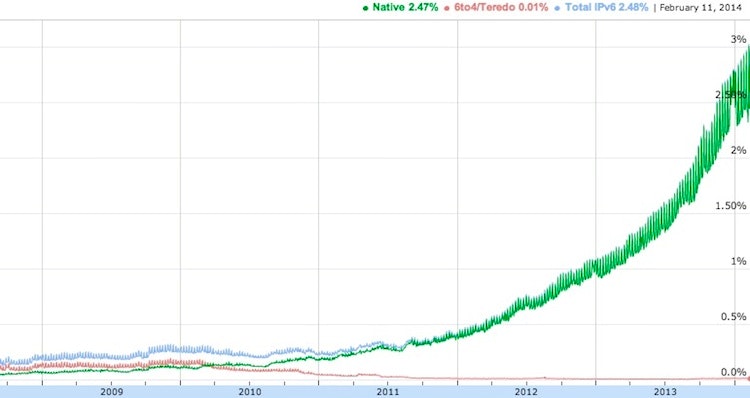IPv6 Gets Real

Google’s IPv6 measurements crossed the 3% milestone just under five months from when the 2% milestone was crossed. Prior to that it had taken 11 months to go from 1% to 2%.
Google is measuring the percentage of users that access Google services over IPv6. Given the range of IPv6-connected services that Google offers, including YouTube, Google+, and Gmail, these measurements provide a good view into the amount of IPv6 deployed in access networks around the world.
The total percentage of IPv6 traffic is expected to cross 10% this year.
Implications
It is clear that IPv6 is no longer something that will be mythically deployed “some day“. IPv6 deployment is happening. If you haven’t been thinking about making your content available over IPv6 and/or making your network work over IPv6, now is the time.
Why IPv6?
If you aren't a networking expert here's the basics:
- "IP" means Internet Protocol. It's how our devices speak to other.
- Every device (Every computer, mobile phone, etc.!) connected to the Internet needs a numerical IP address in order to communicate with other devices. You can think of it as a unique "phone number".
- The original IP address scheme, called IPv4, is running out of numbers. It only allowed for ~4 billion addresses.
- There are more than 7 billion people on the planet (and I personally have many internet devices).
- IPv6 solves the problem of addess space. RFC 2374 defines public addresses as being in the range 2000:: to 3FFF:FFFF:FFFF:FFFF:FFFF:FFFF:FFFF:FFFF. This gives us 2^125 Public IP addresses. According to someone with better math skills than I this equals 4.2×10^37 42 undecillion IPv6 addresses currently defined and usable.
Mind = Blown
Sources:
